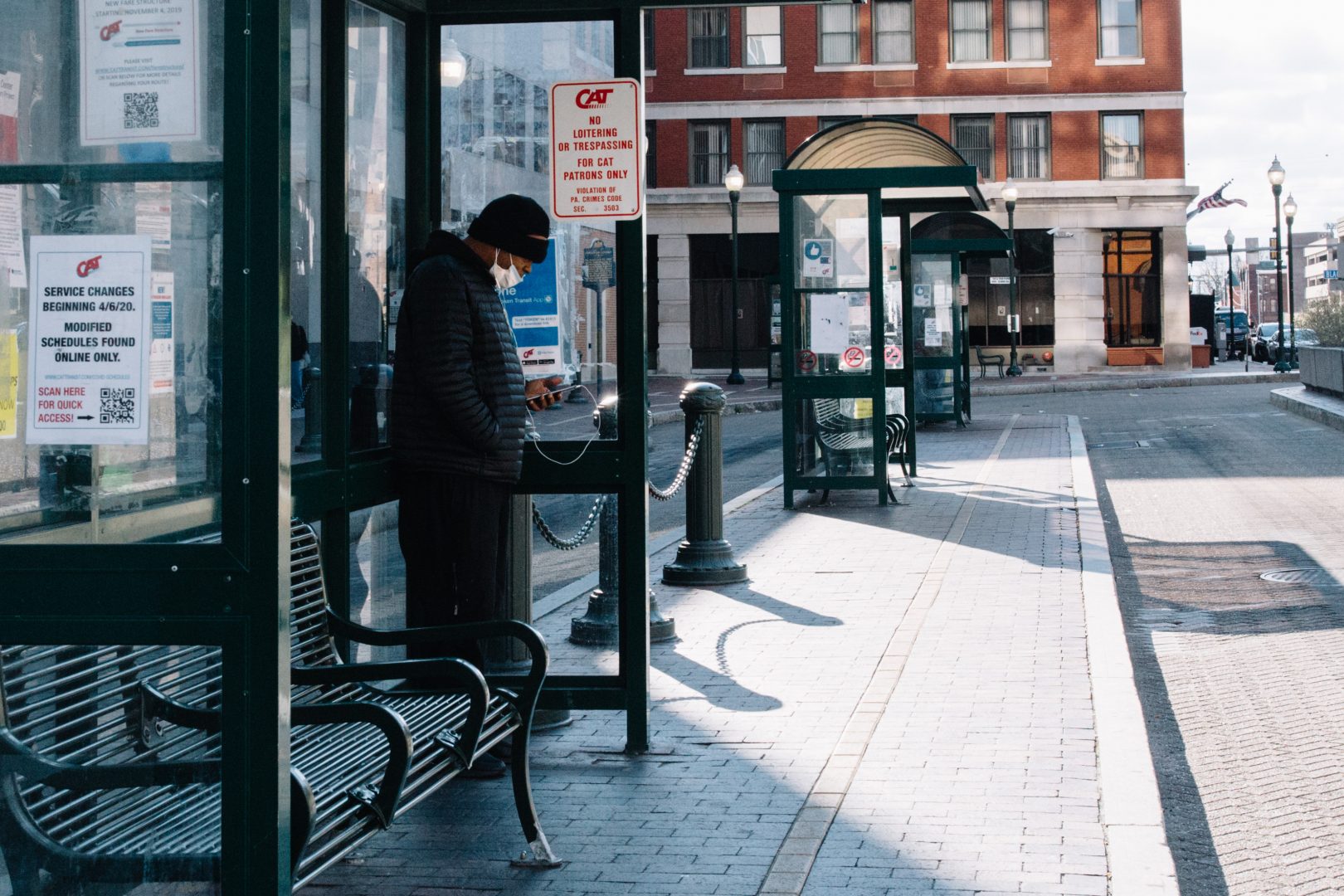
A man wearing a mask over his mouth checks his phone while waiting for a bus in Harrisburg on April 10, 2020.
Kate Landis / PA Post

A man wearing a mask over his mouth checks his phone while waiting for a bus in Harrisburg on April 10, 2020.
Kate Landis / PA Post

Kate Landis / PA Post
A man wearing a mask over his mouth checks his phone while waiting for a bus in Harrisburg on April 10, 2020.
What you should know
» Coronavirus facts & FAQ
» Day-by-day look at coronavirus disease cases in Pa.
» What the governor’s stay-at-home order means
In cities like Milwaukee, New Orleans and Boston, black residents have been dying from COVID-19 at higher rates than white residents. Local public health researchers and advocates worry the same might be happening in Allegheny County.
The race of 39 percent county residents who have tested positive for COVID is unknown, though at least 14 percent of all cases and 16 percent of deaths have been in black patients. African American residents comprise nearly 14 percent of the county’s populations.
A map shows the most confirmed cases tend to be in predominately white communities. By contrast, the larger an area’s black population, the less likely it is to have any confirmed cases.
For example, among the city’s 10 whitest neighborhoods, the map shows a current total of 28 cases, while the 10 blackest neighborhoods have just six cases.
“I just don’t believe that is real. I just don’t believe that that’s case and I think individuals in that community aren’t getting tested,” said Dr. Utibe Essien, an internal medicine physician at the University of Pittsburgh.
Because the data are being given at the neighborhood level, as opposed to zip code, it’s harder to see if the same disparity is reflective of income inequality. However, the wealthier neighborhoods of Squirrel Hill, Shadyside, Point Breeze and Highland Park all have higher rates of COVID-19, per capita, when compared to the county as a whole.
Essien, who is a core investigator at Pitt’s Center for Health Equity Research and Promotion, said the lack of testing, especially among black residents, is due to limited health care access, bias and mistreatment on the part of providers, and a distrust of the medical system.
“Unfortunately, I do feel that as increasing testing is done, we are going to see the numbers switch in a way that is more representative what’s going on in the rest of the country, in Milwaukee, Chicago, New Orleans and New York City,” he said.
This unequal distribution of disease might exist for a number of reasons.
One is that preexisting conditions, like lung and heart disease, which make COVID illness more severe, are more prevalent in black communities. Black Americans are also more likely to be low income, so they could lack the resources to effectively protect themselves from COVID infections.
Dr. Debra Bogen, head of the Allegheny County Health Department, said at a Wednesday press conference that the county’s first confirmed COVID cases clustered around people who had recently traveled, and that later infections were due to community spread.
“The effected communities will probably be changing over time as we’ve seen in other cities,” she said. “There’s also been very limited testing-based specific criteria.”
In addition to travel, triage guidelines for testing include people who are in the hospital, health care workers and residents of long-term care facilities. Some of these criteria are borne out in the county’s map.
For example, Pittsburgh’s Glen Hazel neighborhood has the most confirmed COVID cases in the entire county. Unlike many areas with high case counts, the neighborhood is one of the more diverse and less affluent communities in the city. But it’s also home to a county-owned long-term care facility that’s dealing with a significant COVID-19 outbreak that has killed at least six residents and infected another 35.
In Oakland, where the poverty rate is relatively high due to the neighborhood’s concentrated population of college students, there are also higher numbers of COVID cases. Oakland is home to many college students, a population that is more likely to travel and receive financial support from their families.
Testing capacity is increasing
Allegheny Health Network recently opened sites in Braddock and on the North Shore. As supply chains catch up, ideally community health centers, which are located in low-income areas, will start testing patients.
“I think it’s really important that we look at our testing across time,” said Bogen. “As we get more testing available, we’re able to test more broadly.”
Essien said this is imperative. Though a confirmed COVID case and a presumptive COVID case receive the same medical advice and treatment, better data will illuminate the extent to which these racial disparities exist, and direct future policy.
“That data will help drive resources, [like] were vaccinations goes,” he said.
Because COVID-19 has not yet overwhelmed Allegheny County hospitals and clinics, Essien said now is the time for health systems and government agencies to reach out to the black community, and address equity and access issues.
The days of journalism’s one-way street of simply producing stories for the public have long been over. Now, it’s time to find better ways to interact with you and ensure we meet your high standards of what a credible media organization should be.